
A certain beat or rhythm keeps your heart healthy so that it can carry on its function smoothly. If the pace is irregular, the heart might beat too fast or too slow or just miss a beat. Heart rate in children can differ depending on factors like the child’s age, overall health, and activity level, like whether the child is resting or moving at the time the pulse is recorded. Even emotional wellbeing can have an impact on heart rate.
Abnormal heart rate is not rare among the children. Their heart will slow down or speed up now and then. However, when the pace becomes faster than what has been considered normal for a particular duration, it could be a sign of a problem. Therefore, it is important to understand and differentiate the normal and abnormal heart rate in children.
What is Heart Rate in Children?
Heart rate in children or pulse is the number of times the heart beats per minute. By taking the pulse, doctors can tell important things about your child’s health.
What is The Normal Heart Rate in Children?
The age group determines the ‘normal’ average heart rate in children. As a newborn grows into a toddler and then a youngster, the normal heartbeat varies. Heart rate tends to decrease from the newborn to adolescence. The following chart (source) helps you to get an idea about the average heart rate (pulse rates) for children under different age groups.
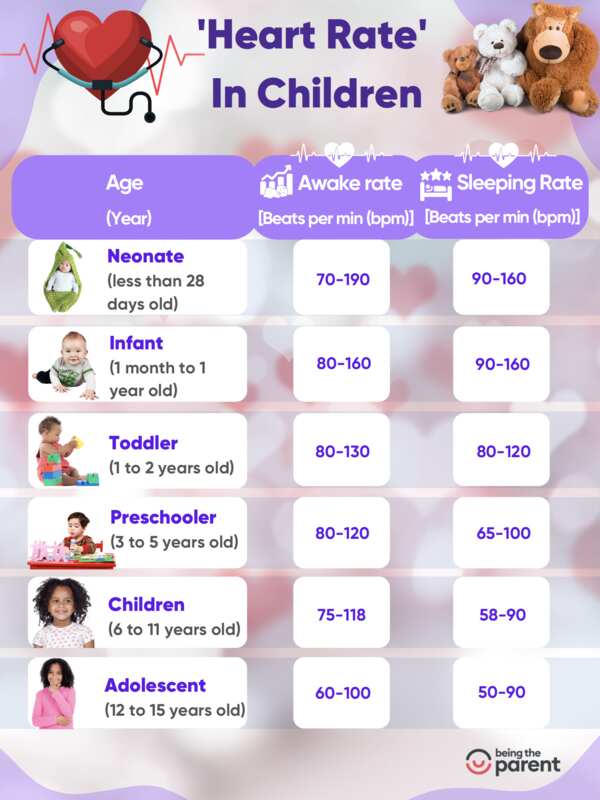
What is A Dangerous Heart Rate For a Child?
Young children usually have higher heart rates in comparison with adults. Whenever the heart rate falls out of the normal range for their age group, it is considered abnormal and needs an evaluation.
The normal range is as follows –
Newborn- 3 months – 70–190 beats per minute while awake, 90–160 beats per minute while asleep
3 months to 2 years -100–190 beats per minute while awake, 75–160 beats per minute while asleep
2 years to 10 years – 60–140 beats per minute while awake, 60–90 beats per minute while asleep
Over 10 years – 60–100 beats per minute while awake, 50–90 beats per minute while asleep
What is a Dangerous Heart Rate For a Child While Sleeping?
Heart rate usually falls to the lower end of the normal range when a child is sleeping. It is important to know that heart rates change during different stages of sleep. A consistently low heart rate below the normal range is considered abnormal and needs further monitoring.
The normal range is as follow –
Newborn- 3 months – 80–160 beats per minute while asleep
3 months to 2 years -75–160 beats per minute while asleep
2 years to 10 years – 60–90 beats per minute while asleep
Over 10 years – 50–90 beats per minute while asleep
How to Bring a Child’s Heart Rate Down?
You can calm your child’s pacing heart rate by comforting them. You can make them sit or lie down and ask them to relax. Putting a cold, wet cloth over the face helps bring the heart rate down. The best is to seek help from a healthcare professional.
What is a Dangerous Heart Rate For a Child With Fever?
A dangerous heart rate for a child with a fever, or tachycardia, is generally considered to be above 160 beats per minute (bpm) for infants under 12 months, above 150 bpm for children 12-24 months, and above 140 bpm for children 2-4 years old.
What is Arrhythmia in Children?
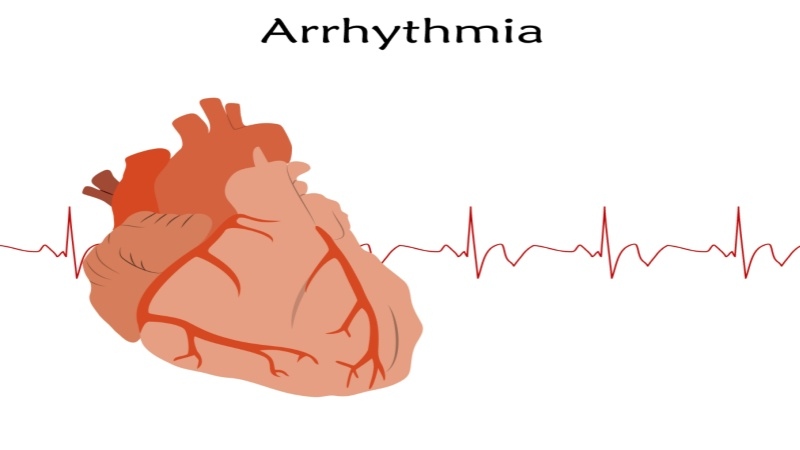
The healthy heart should beat powerfully with a regular rhythm. Abnormal heart rate with irregular (too fast and too slow) rhythm is called arrhythmia (1). If the pulse is too high, it is called tachycardia, or too low, it is called bradycardia. Most arrhythmias are harmless, but sometimes it can be dangerous as the irregular flow of blood can damage vital organs.
Types of Arrhythmia
There are two types of arrhythmia-
- Tachycardia
- Bradycardia
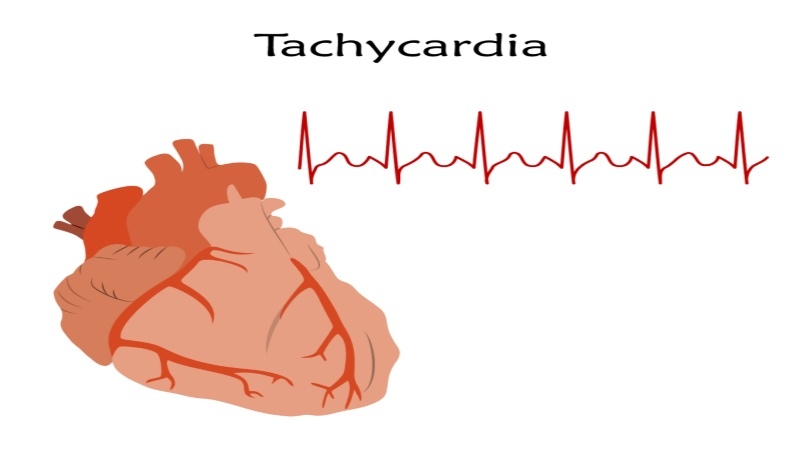
Tachycardia occurs in children when the heart beats too fast. Generally, it does not last for a long time in order to cause any serious organ damage. Basically, there are two main types of tachycardia-
1. Ventricular Tachycardia
This involves the ventricles only. It is rare in children and an early identification can be life-saving as it raises the risk of sudden cardiac arrest.
2. Supraventricular Tachycardia (SVT)
SVT is the most common type of tachycardia in children, and it is also known as paroxysmal atrial tachycardia (2). It occurs due to rapid misfiring of electrical impulses in the upper chambers of the heart or the atria causing a racing on heart rate lasting for seconds to minutes.
Different Types of SVT
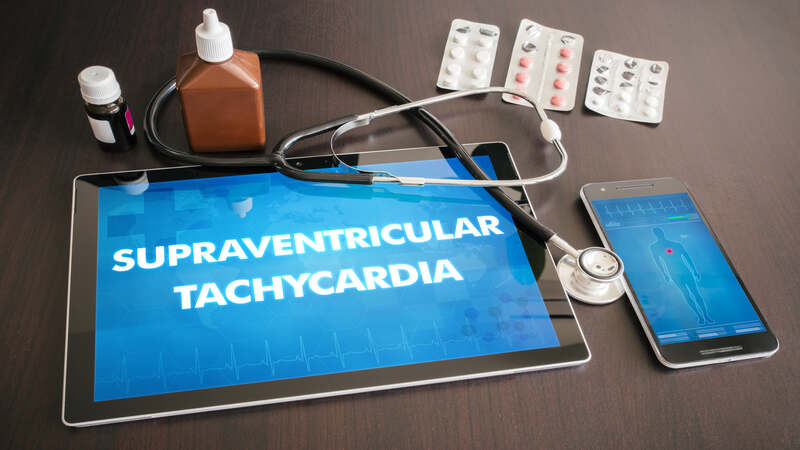
There are different types of SVT. Some of the main types include-
1. Atrioventricular nodal reentry tachycardia (AVNRT)
This happens due to an additional electrical circuit within or near the AV node (3). This extra pathway causes the heart to beat much faster than the normal.
2. Atrial Flutter
Atrial flutter or fibrillation occurs when the electrical impulses from the atria are faster than that of the ventricles.
This causes the heart to flutter abnormally and irregularly rather than beating normally. It is a very rare condition in the pediatric age group (4). This condition makes the heart pump blood ineffectively. As a result, the body cells may not be able to receive enough blood.
3. Atrial Ectopic Tachycardia (EAT)
This condition affects the upper chambers of the heart or the atria making them beat faster than the ventricles. It causes the heart to beat abnormally faster than the normal.
What is Bradycardia in Children?
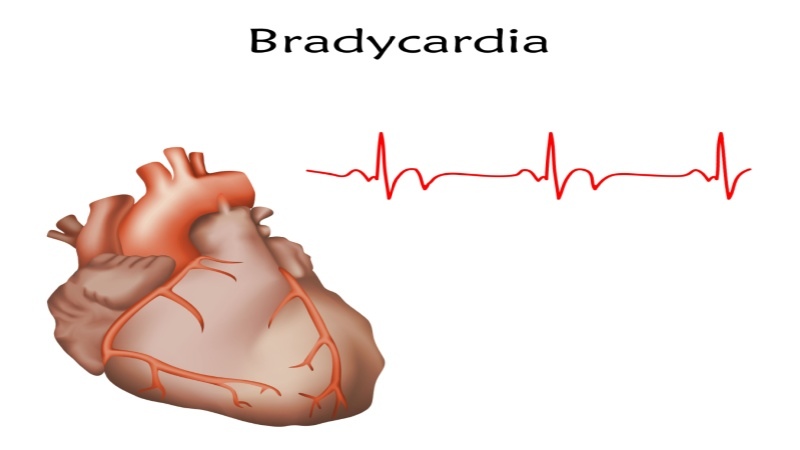
Bradycardia refers to a heart rate in children lower than the normal range for the age (5). The heart rate will fall below 50 bpm. For some children, a slower heart rate does not bring on any problem. However, bradycardia can also indicate issues with the heart’s electrical framework. It implies either the heart’s natural pacemaker is not working in the approved manner or that the electrical pathways of the heart are interrupted. In severe types of bradycardia, the heartbeats become too slow that it does not pump sufficient blood to satisfy the body’s requirements. This can cause complications and can be life-threatening.
When to Take Your Child’s Pulse?

Usually, there is no need for you to check your child’s heart rate. The doctor will evaluate it during checkups. But if your child has a medical condition that requires you to monitor the heart rate from time to time, your doctor will tell you when and how to take the pulse. You should take a pulse of your child if-
- Your child complains of heart palpitations
- They feel that the heart is skipping a beat
- Has chest pain and feels dizzy
- They are not asthmatic but have trouble breathing
- They suddenly become unconscious or black out
- Their skin turns pale, and their lips become blue
How to Take Your Child’s Pulse?

For taking your child’s pulse, you will need a watch or a stopwatch. If your child was physically active, then wait for a few minutes for the heart rate to return to normal. To feel a pulse, press your pointer and middle finger on a major artery in the body. You will feel a throbbing sensation when you locate a pulse.
- To take a pulse, you should first know the different pulse points. There are different areas on the body from where you can read a pulse. Some of them are- on the neck, on the wrist, in the armpit or in the crease of the elbow
- Once you have located the pulse, begin counting the beats for 30 seconds. After 30 seconds, stop. Note down the number of beats and double it to get the per-minute heart rate (6). For example, if you have counted 40 beats in 30 seconds, then your child’s heart rate in a minute would be 40 X 2= 80 beats per minute. So the heart rate of your child would be 80
How is Arrhythmia in Children Diagnosed?
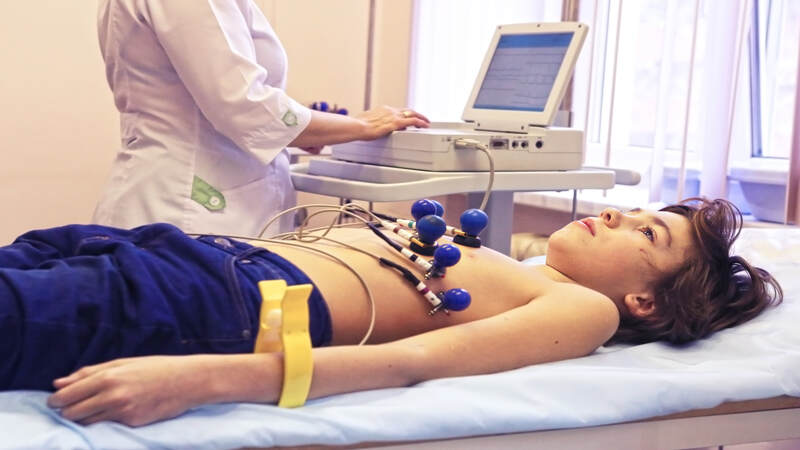
Along with the medical history and physical examination of your child, the doctor will use various procedures to diagnose abnormal heart rate in children-
- Electrocardiogram (ECG ): It is the measurement of the electrical activity of the heart (7). An ECG can detect any abnormal heart rate or any type of heart condition in your child. ECG can be done as Resting ECG or Exercise ECG / Stress test.
- Holter Monitor: This is an ECG recording over a period of 24 hours or more (8). Holter monitoring is of two types: continuous monitoring where ECG is recorded throughout the testing period, or event monitor in which ECG is recorded when the child starts to feel any symptoms or abnormal heart rate is detected.
- Electrophysiology Study (EPS): This is an invasive test in which a catheter is inserted into the blood vessel anywhere in the leg or the arm that leads to your child’s heart. This test helps to find out the origin of arrhythmia in the heart.
- Tilt Table Test: Tilt table test is recommended to children with regular episodes of fainting or unexplained syncope (9). This test helps determine in what ways the blood pressure, oxygen levels, and heart rate in the children change with any change in the position, i.e., lying down or standing up.
How to Treat Abnormal Heart Rate in Children?
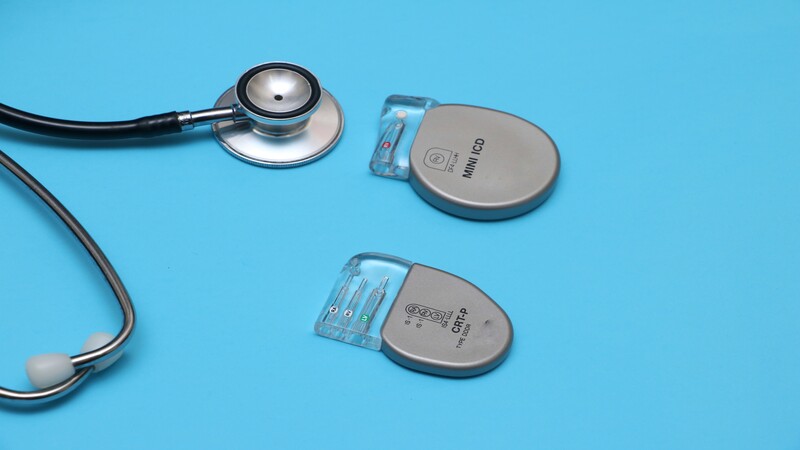
The treatment of arrhythmia in children is usually determined by-
- Age of the child
- Type of arrhythmia
- Frequency of arrhythmia
- Symptoms
Arrhythmia or Abnormal heart rate in children can be treated by using-
- Medicines that correct the abnormal heart rate.
- Catheter ablation: Here a catheter is inserted through a vein from the leg that leads to the heart.
- Pacemakers: Here, the doctors use implant devices such as pacemakers that help the heart to beat normally. It is mostly used to treat third degree AV block (10).
- Defibrillators: This involves placing a small battery-operated device called the implantable cardioverter-defibrillator (ICD) near the collarbone (11).
- Surgery: Surgery is only recommended when all the other options have failed.
When to Seek Medical Attention

Regardless of the physical activity, if your child’s heart rate is too fast to count or slow, then it is better to get it checked by a doctor. Sometimes abnormal heart rate can indicate underlying heart problems in your child, which should not be neglected.
As parents, you would want your little one to always be healthy and play around. Making sure that their pure and beautiful heart is working well is really important for parents. Having knowledge about the normal range for heart rate and the factors influencing it is essential. If you feel that your child’s heart rate is abnormally fast or slow, then don’t hesitate to talk to their healthcare provider.
FAQ’s
1. What Is A Dangerous Heart Rate For A 12-Year-Old?
For a 12-year-old child, a heartbeat above 100 bpm or below 60 bpm while resting is considered to be dangerous and needs medical intervention.
References
- What Is an Arrhythmia? – [https://www.nhlbi.nih.gov/health/arrhythmias]
- Tachycardia: Fast Heart Rate – [https://www.heart.org/en/health-topics/arrhythmia/about-arrhythmia/tachycardia–fast-heart-rate]
- Atrioventricular Nodal Reentry Tachycardia – [https://www.ncbi.nlm.nih.gov/books/NBK499936/]
- Atrial Flutter: An Uncommon Pediatric Manifestation of Hyperthyroidism – [https://publications.aap.org/pediatrics/article-abstract/100/2/e11/38921/Atrial-Flutter-An-Uncommon-Pediatric-Manifestation?]
- Evaluation and management of bradycardia in neonates and children – [https://link.springer.com/article/10.1007/s00431-015-2689-z]
- Pulse – [https://www.ucsfbenioffchildrens.org/medical-tests/pulse]
- Electrocardiography for Children – [https://www.urmc.rochester.edu/encyclopedia/content.aspx?contenttypeid=90&contentid=P01785]
- Ambulatory ECG Monitoring – [https://www.ncbi.nlm.nih.gov/books/NBK597374/]
- Head-up tilt test: A highly sensitive, specific test for children with unexplained syncope – [https://link.springer.com/article/10.1007/BF02505089]
- Pacing in children – [https://www.ncbi.nlm.nih.gov/pmc/articles/PMC3634247/]
- Implantable Cardioverter Defibrillator (ICD) – [https://www.heart.org/en/health-topics/arrhythmia/prevention–treatment-of-arrhythmia/implantable-cardioverter-defibrillator-icd]

